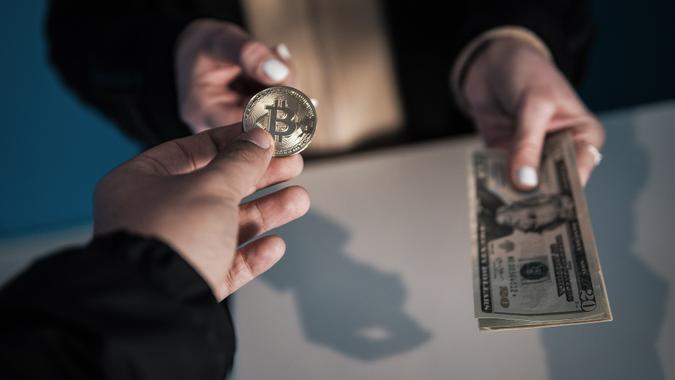Binance Fees: A Full Breakdown and How It Compares
Binance Fees: A Full Breakdown and How It Compares

Alihan Usullu / iStock.com
Binance has positioned itself as a leader among cryptocurrency trading platforms around the globe, with the aim of making it easy for both beginners and experts to trade crypto while also enjoying competitive rates.
Like any trading platform, Binance charges fees for certain trades and services. Understanding the Binance platform and its fee structure helps you keep costs down so more of your investment goes into your wallet. Keep reading to learn more.
What Is Binance?
Binance is a crypto-to-crypto exchange service that got its start in 2017 in Hong Kong. It has since grown into one of the world’s most popular crypto exchanges. In addition to trading, Binance offers savings options, the Binance Smart Pool for miners, the Binance Visa card, crypto loans and more.
Binance’s U.S. platform, Binance.US, was launched in 2019 and has its own schedule of fees. It’s available for users in every state except Connecticut, Hawaii, Idaho, Louisiana, New York, Texas and Vermont.
Binance allows trades, deposits and withdrawals in almost 200 types of crypto, including:
Binance Fees
Binance offers some of the lowest fees in the crypto exchange market, making it a favorite among traders. Here’s a quick rundown of some of the fees you might face.
Building Wealth
Purchase Fees
If you choose to buy your cryptocurrencies with a debit or credit card, you can expect to pay up to 4.50% in fees. Because of these fees, you’re better off using other payment methods.
Wire transfers, on the other hand, come with no transaction fee but are not available everywhere. If your location does support wire transfers, you can use them to avoid paying card fees.
Deposit Fees
There are no fees when depositing crypto assets on Binance with Bitcoin (BTC), Tether (USDT) and Ethereum (ETH). You’ll first need to exchange your fiat for crypto and then make your deposit.
Trading Fees
Binance charges a 0.10% fee for trading on the platform as well as a 0.50% fee for Instant Buy/Sell, so your actual fee amount will depend on the amount of the trade. The higher the transaction, the higher the fee. One way to lower your trading fee is to keep some Binance Coin in your account at all times so your fees can be taken from that. Doing this fetches you a 25% discount on all trading fees.
Withdrawal Fees
Fees are also incurred based on the type of crypto you are withdrawing. These fees change with the market’s status, making it difficult to know what you owe until you’re ready to withdraw. Be sure to check the Binance.US website, which provides up-to-date information for each type of cryptocurrency.
Building Wealth
There are ways to lower withdrawal fees, and it starts with understanding that the fees are based on the type of crypto asset you want to withdraw. Some assets charge higher rates than others, so reducing withdrawal fees can be as simple as changing the coin.
Before you begin your withdrawal, check the rates on the coin you plan to request. Some of the highest fees come from these currencies:
- LLToken
- Chainlink
- Chatcoin
- Vibe
- Cindicator
- Ethlend
- Tronix
- SONM
- Etherparty
- WePower
- Decentraland
If the type of asset you were about to request has a high fee, consider trading and converting to Bitcoin or Ethereum first. You can also choose a less expensive crypto, such as one of the following:
- Verge
- Steem
- Litecoin
- Ethereum Classic
- Cloak
- Bitcoin Gold
- PIVX
Under most circumstances, taking the time to compare withdrawal rates can make a significant impact on the total amount of fees you pay.
Maker or Taker
When you check Binance fee schedule, you’ll notice that different fees are charged depending on whether you’re a “maker” or a “taker.”
Building Wealth
According to the Binance website, maker trades happen when you place an order that goes on the order book partially or fully, such as a limit order placed via the trading screen on binance.com. Any subsequent trades coming from that order will be maker trades. The name is based on the fact that these orders add volume to the order book, helping to “make” the market.
Taker trades occur on an order that trades immediately before going on the order book, regardless of whether you partially or fully fulfill an order. These trades “take” volume off of the order book.
How Binance Fees Compare to Other Exchanges
Comparing the fees at different crypto exchanges is tricky because they don’t all have the same fee structures or deal in the same coins, but it’s still a good idea to familiarize yourself with some of the individual features.
Here’s a quick look at some of the fees you might face at a few of the leading exchanges, and how they compare to Binance.
Exchange
Fee Details
Binance.US
-0.10% trading fee
-0.50% Instant Buy/Sell fee
-25% if using Binance coin
Gemini
-0.50% convenience fee
-$0.99 to $2.99 transaction fee
-1.49% transaction fee for trades over $200
Bittrex
-0.00%-0.35% maker/taker fees
Coinbase
-0.50% spread
-Trading fee between 1.49% and 3.99% (or $0.99 to $2.99 flat fee)
-2.49% flat fee on transactions made with other cryptos
-2% fee for credit transaction
CEX.IO
-0% – 0.25% maker/taker fees
-Deposit/withdrawal fees up to 3.99%
Information is accurate as of June 29, 2022.
Our in-house research team and on-site financial experts work together to create content that’s accurate, impartial, and up to date. We fact-check every single statistic, quote and fact using trusted primary resources to make sure the information we provide is correct. You can learn more about GOBankingRates’ processes and standards in our editorial policy.
-
TIME. 2021.
“Binance.US Review 2021.”
About the Author

Brandy Woodfolk
Brandy Woodfolk is an entrepreneur, teacher, and freelance writer. She received my Bachelor of Business Administration from Everest College, Digital Marketing Certification from Shaw Academy, Certificate in Personal and Family Financial Planning from the University of Florida Through Coursera, and she is completing her Master’s of Project Management from Northcentral University. She has dedicated her freelance writing career to creating content related to digital marketing and SEO, business, personal finance, family, and health and wellness.
